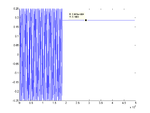palermo
Newbie level 6
Dear community,
I have designed a 1st order 1-bit delta-sigma modulator. I have implemented the fully differential architecture proposed on p31 of Schreier's "Understanding Delta-Sigma Data Converters" book. After running the simulation in Cadence, I import the data into Matlab to process it.
So as to have a high resolution fft, I want to run a simulation for 200 periods of input signal. However, resulting output signal is very well for first ~100 period and then sticks to the rails.
Do you have any idea why this happens?
Enclosed are the output graphics.
Thanks in advance!



I have designed a 1st order 1-bit delta-sigma modulator. I have implemented the fully differential architecture proposed on p31 of Schreier's "Understanding Delta-Sigma Data Converters" book. After running the simulation in Cadence, I import the data into Matlab to process it.
So as to have a high resolution fft, I want to run a simulation for 200 periods of input signal. However, resulting output signal is very well for first ~100 period and then sticks to the rails.
Do you have any idea why this happens?
Enclosed are the output graphics.
Thanks in advance!




